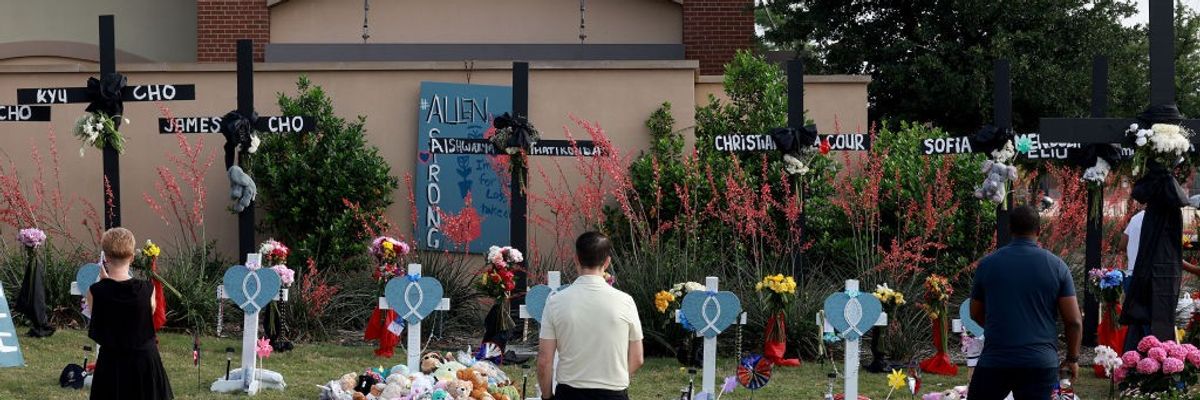More mass killings. More bloody “normal”—not just in Texas, not just in the United States, but around the world.
Eerily, Texas Gov. Greg Abbott inadvertently reminded us of the international nature of this scourge when he referred to five recent murder victims, in a tweet announcing a $50,000 reward for the killer, as “illegal immigrants.”
Hey, this is a divided world! Were you aware of that?
There’s “us” and there’s “them”—which apparently is a viewpoint that a mass shooter shares with the governor of Texas. Abbott, of course, was inundated with flak and wound up apologizing for his careless tweet, but the reality of it won’t go away. A private belief—that someone’s immigration status matters more than life itself—suddenly went public.
Those on both sides of a divide—be it national, ethnic, racial, political or whatever—are united in their dismissal of each other’s humanity.
And a door of awareness opens. This is about dehumanization. And it’s not an individual flaw. It’s part of our collective psychology. Ironically so. Those on both sides of a divide—be it national, ethnic, racial, political or whatever—are united in their dismissal of each other’s humanity.
Recent mass shootings include the two in Texas: In Allen, a gunman walked into an outdoor shopping mall on May 6, carrying three weapons, and opened fire at the shoppers; he killed eight people, including three children. And in the Dallas suburb of Cleveland, a gunman killed five of his neighbors on April 28, who had asked him to stop shooting his rifle in his backyard because the noise was disturbing their baby.
And, in a trans-Atlantic link, there were two recent mass shootings in the gun-saturated nation of Serbia: On May 3, a 13-year-old boy, armed with two of his father’s handguns, opened fire at his school in Belgrade, killing eight classmates and a security guard and wounding seven others. The next day, a 20-year-old wielding an assault rifle and a pistol killed eight people and wounded fourteen in a rural area south of Belgrade.
Serbia immediately erupted in protests and even, apparently, political action. People possessing weapons illegally were given 30 days of amnesty, in which they could turn in their weapons with no questions asked. According to Serbian police, some 1,500 guns were turned in on the first day.
But that’s hardly all the transnational killings of the past few weeks. Mostly they’re committed not by armed loners but by various states. It’s called self-defense. It’s called war. For example, Israel conducted an aerial bombardment of Gaza on May 9, killing thirteen people and wounding twenty. Three of those killed were members of the Palestinian Islamic Jihad movement. The rest were, well, collateral damage, which, of course, is just a word meant to turn a victim into an abstraction. This is how we play war.
Transcending war can only start by turning victims back into human beings, for instance: Two sisters, Dania Adass, age 21, and Iman Alaa Adass, age 17, were killed when their home was hit by one of the Israeli bombs. A cousin told Al Jazeera: “Dania was getting ready for her wedding in a few days, and Iman was sad because her sister was about to leave the family home.” He pointed out Dania’s fiancé, who stood next to her body, weeping and speechless.
The process of not knowing, not caring about, such humanity, at least long enough to kill someone, is known as “othering.” It’s the opposite of connecting and cooperating. It’s the opposite of empathy. When it comes to the mass-killing phenomenon, analysts—not to mention politicians and, oh yeah, pro-gun lobbyists—mostly focus on the mental health of the individuals who commit the crime. Something’s wrong with them. They’ve shut down their empathy.
The serious mistake in this analysis, as far as I’m concerned, is the assumption that people act alone. In a sense, yes, they do: There’s only one person pulling that trigger. But acting alone doesn’t necessarily mean thinking alone. Indeed, lonely, angry, disconnected people are not alone. They’ve merely claimed, as their own, the belief that a given enemy is the cause of their trouble, and there’s only one solution: Eliminate the enemy. Where would such a belief come from?
“Without the creation of abstract images of the enemy, and without the depersonalization of the enemy during training, battle would be impossible to sustain.”
These are the words of Richard Holmes, in his book Acts of War (as quoted by Dave Grossman in On Killing). Holmes also writes:
“... the road to My Lai was paved, first and foremost, by the dehumanization of the Vietnamese and the ‘mere gook rule’ which declared that killing a Vietnamese civilian does not really count.”
OK, so what? How does an attitude like this escape from boot camp into the general public? Lots of ways, as war is glorified by both the news and (especially) entertainment media. War preparation—the endless presence of some enemy or other—contributes, as I say, to our collective psychology.
And it’s not just the unquestioned, ever-expanding, multi-trillion-dollar global military budget. It’s the presence, for God’s sake, of 12,700 nuclear warheads on this planet, 9,400 of which, according to the International Campaign to Abolish Nuclear Weapons, are in active military stockpiles. Nine countries possess nukes; five more “host” them (for the USA, of course). And a total of thirty-four countries, not counting the nine—all of them so-called first-world countries—“endorse” the use of nuclear weapons.
There’s a hostage situation at work here! Our collective psychology is trapped in a cage. Humanity, having divided itself into “us” and “them,” is under its own threat to commit suicide, rather than attempt to understand itself. Lost souls with guns are just doing their part to help out.
